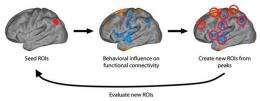June 29, 2011 report
Delayed brain development responsible for juvenile offender behavior

(PhysOrg.com) -- A new study published in the Proceedings of the National Academy of Sciences reveals researchers findings into the delayed development in the brains of juvenile offenders and the fact that this delayed development puts the teens at risk for increased impulse behavior.
Lead researcher Benjamin Shannon from the Department of Radiology at Washington University in St. Louis and his team looked at over 100 juvenile offenders that were being held in maximum security facilities. They discovered a connection between the motor planning regions and attention and control regions of the brain.
Looking at non-offenders, the researchers looked at 95 individuals age 7 to 31 and found that the younger participants showed a strong connection between the motor planning regions and attention and control regions however, as the participants increased in age that connection seemed to fade.
Researchers believe that this delayed development in the juvenile’s brain is something that will eventually be outgrown. While they agree that these offenders deserve punishment for their actions, they believe that more research needs to be done to try and find a way to increase the development in the brain. These juveniles have committed a crime, but that does not mean they are ruined for life and this research shows there is the potential for this impulse behavior to be corrected as brain development continues.
The researchers plan to follow the originally tested offenders to see if the brain patterns do change over time and to look into possible therapy options to speed up the development in their brains.
They also hope that this better understanding of impulse behavior and the brain connection could offer insight to impulse disorders such as attention-deficit hyperactivity disorder, antisocial personality disorder and conduct disorder.
More information: Premotor functional connectivity predicts impulsivity in juvenile offenders, PNAS, Published online before print June 27, 2011, doi:10.1073/pnas.1108241108
Abstract
Teenagers are often impulsive. In some cases this is a phase of normal development; in other cases impulsivity contributes to criminal behavior. Using functional magnetic resonance imaging, we examined resting-state functional connectivity among brain systems and behavioral measures of impulsivity in 107 juveniles incarcerated in a high-security facility. In less-impulsive juveniles and normal controls, motor planning regions were correlated with brain networks associated with spatial attention and executive control. In more-impulsive juveniles, these same regions correlated with the default-mode network, a constellation of brain areas associated with spontaneous, unconstrained, self-referential cognition. The strength of these brain–behavior relationships was sufficient to predict impulsivity scores at the individual level. Our data suggest that increased functional connectivity of motor-planning regions with networks subserving unconstrained, self-referential cognition, rather than those subserving executive control, heightens the predisposition to impulsive behavior in juvenile offenders. To further explore the relationship between impulsivity and neural development, we studied functional connectivity in the same motor-planning regions in 95 typically developing individuals across a wide age span. The change in functional connectivity with age mirrored that of impulsivity: younger subjects tended to exhibit functional connectivity similar to the more-impulsive incarcerated juveniles, whereas older subjects exhibited a less-impulsive pattern. This observation suggests that impulsivity in the offender population is a consequence of a delay in typical development, rather than a distinct abnormality.
© 2010 PhysOrg.com















